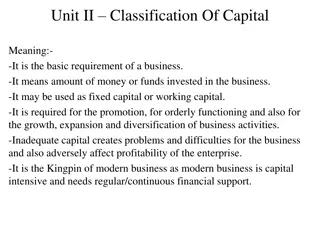Capital Account Convertibility (CAC) and its Implications in India
Capital Account Convertibility (CAC) refers to the freedom to convert local financial assets into foreign assets at market-determined exchange rates. India currently has partial CAC, leading to conflicting views on moving towards full convertibility. CAC impacts flows of portfolio capital, FDI, borrowed funds, dividends, and interest payments. It offers benefits like access to international markets, cost reduction, and financial system enhancement according to the Tarapore Committee. However, it also poses risks due to exchange rate volatility.
Download Presentation

Please find below an Image/Link to download the presentation.
The content on the website is provided AS IS for your information and personal use only. It may not be sold, licensed, or shared on other websites without obtaining consent from the author.If you encounter any issues during the download, it is possible that the publisher has removed the file from their server.
You are allowed to download the files provided on this website for personal or commercial use, subject to the condition that they are used lawfully. All files are the property of their respective owners.
The content on the website is provided AS IS for your information and personal use only. It may not be sold, licensed, or shared on other websites without obtaining consent from the author.
E N D
Presentation Transcript
Capital Account Convertibility (CAC) is the freedom to convert local financial assets into foreign financial assets at market determined exchange rates. Referred to as Capital Asset Liberation in foreign countries, it implies free exchangeability of currency at lower rates and an unrestricted mobility of capital India, at present has partial capital account convertibility with certain limits and caps on FDI In India there are conflicting views regarding whether to move towards full convertibility of capital account or not CAC and SS Tarapore Committee
CAC is related with flows of portfolio capital, FDI flows, flows of borrowed funds and dividends and interest payable on them. Under CAC, a currency is freely convertible into foreign currency and vice-versa at market determined exchange rate Convertibility of rupee on capital account means those who bring in purchasing stocks, bonds in Indian stock markets or for direct investment can get them freely converted into rupees without taking any permission from the government foreign exchange for
Dividends, interest, capital gains earned on direct investment can be converted into foreign currencies at market determined exchange rate between these currencies and repatriate them Capital exchange rate more volatile. It is introduced only some time after the introduction of convertibility on current account when exchange rate is relatively stable, deficit in balance of payments is well under control and enough foreign exchange reserves are available with the Central Bank convertibility is risky, makes foreign
The Benefits of Capital Account Convertibility (TaraporeCommittee) 1. Availability of large funds to supplement domestic resources and thereby promote economic growth. 2. Improved access to international financial markets and reduction in cost of capital 3. Incentive for Indians to acquire and hold international securities and assets 4. Improvement of the financial system in the context of global competition
ADVANTAGES OF CURRENCY CONVERTIBILITY 1.Encouragement to profitability. 2. Encouragement to import substitution 3. Incentive to send remittances from abroad: 4. A self balancing mechanism to correct BOP exports increasing 5. Specialization in accordance with comparative advantage 6. Integration of World Economy
Convertibility of Indian Rupee At the time of independence the ForeignExchange Regulation Act 1947 (FERA) was enacted with the object of regulating certain dealings in foreign exchange and the import and export of currency and bullion The focus of this act was on dealings in Foreign exchange and payments which directly affect foreign exchangeresources. This act was later replaced by the Foreign Exchange Regulation, Act, 1973, which we call FERA. Later FERA was laid to rest and its successor is now FEMA
Full Convertibility of Rupee on Current Account In 1992, Government announced intention to introduce the full convertibility on the current account in 3 to 5 years Full convertibility means no RBI dictated rates and a unified market determined exchange rate regime Encouraged with the success of the LERMS, the government introduced the full convertibility of Rupee in Trade account (means only merchandise trade no service trade) from March 1993 onwards With this the dual exchange rate system got automatically abolished and LERMS was now based upon the open market exchange The full convertibility of Rupee was followed by stability in the Rupee Rate in the next many months coming up
In August 1994, declared full convertibility of Rupee on Current account with announcing some relaxations as per requirements of the Article VIII of the IMF These were: Repatriation of the income earned by the NRIs and overseas corporate bodies of NRIs in a Phased manner in 3 yearsperiod Ceiling for providing foreign exchange for foreign tours, education, medical treatment, gifts and services was made just an indicative Above this ceiling, foreign exchange could be obtained for payments, while making a reference to RBI Principal amount on the NRNR (Non Resident Non Repatriable) Accounts was non repatriable, the interest was made repatriable
ADVANTAGES OF CURRENCY CONVERTIBILITY 1. Encouragement to exports 2. Encourages import substitution 3. Incentive to remittances from abroad 4. Reduction in Malpractices 5. A self balancing mechanism






















